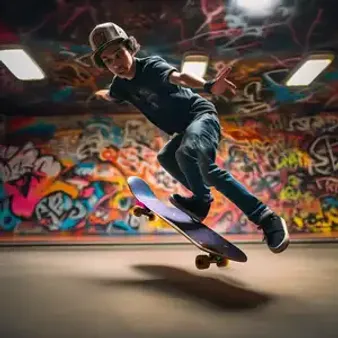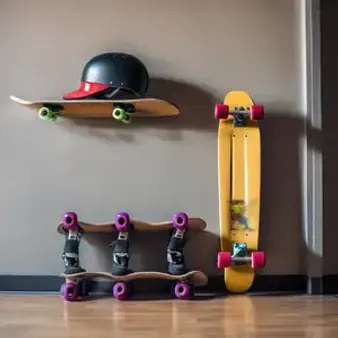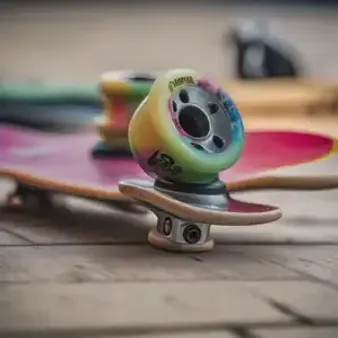Table of Contents
Want to skateboard inside year-round? You don't need a giant warehouse to have fun skateboarding inside. Whether you're building a mini ramp in your basement or perfecting ollies in the hallway, kizworld has tips and tricks for making the most of your indoor skateboarding sessions.
Feature | Description |
|---|---|
Safety Gear | Helmet, knee pads, elbow pads, wrist guards are essential, even indoors. |
Space Requirements | Clear a large, open area free of furniture and obstacles. Basements, garages, and even hallways can work. |
DIY Ramps and Obstacles | Get creative with plywood, cinder blocks, and other materials to build your own ramps and obstacles. |
Indoor Skateboard Options | Consider cruiser boards or longboards for smoother riding on slick indoor surfaces. Softer wheels can also help. |
Setting Up Your Indoor Skate Park
Finding the Perfect Spot
First things first, you need to find the perfect spot in your house to set up your indoor skate park. Look for a room with plenty of open space, like the basement, garage, or even a large hallway. You'll want enough room to move around freely without bumping into furniture or walls. Trust me, a dented coffee table is not a good look! Plus, the more space you have, the more creative you can get with ramps and obstacles. Speaking of which… let’s talk about building your dream indoor skate park!
Remember that time you aced that 180? Now imagine practicing indoors! To get started, clear out any clutter or furniture that might get in the way. You’ll want a nice, big open space where you can move around freely. Think of it like this – the bigger the space, the bigger the tricks!
Space | Pros | Cons |
|---|---|---|
Basement | Often large and open, good for ramps | Might need better lighting |
Garage | Easy access for bringing in ramps | Could be cold in the winter |
Hallway | Good for practicing balance | Limited space for tricks |
Building Your Dream Park
Now for the fun part – designing your indoor skate park! You don't need a ton of fancy equipment to create an awesome setup. Simple things like plywood ramps, cinder blocks, and even old furniture can be transformed into killer obstacles. Get creative and let your imagination run wild! Just make sure everything is sturdy and secure before you start skating. Safety first, always! And hey, if you're feeling extra ambitious, you can even paint your obstacles with cool designs and graffiti art. It's your indoor skate park, so make it your own!
Setting Up Your Indoor Skate Park
Mastering Tricks with Indoor Skateboarding
Perfecting Your Ollie
Inside, you can really focus on nailing those fundamental tricks. Let's start with the ollie – it's like the foundation of skateboarding. You know how in skateboarding for beginners, you learn to pop that board up? Well, practice makes perfect! Find a spot in your indoor skate park where you've got some space. Start by just getting comfortable with the pop – that upward jump motion while you slide your front foot up the board. It's all about timing and balance. Once you're feeling good about the pop, try a little hop. Remember, you don't need a ton of speed indoors, so focus on getting that clean, controlled ollie.
From Ollie to Kickflip
Now that you're getting the hang of the ollie, let's take it up a notch with the kickflip! This one's a bit trickier, but super rewarding once you land it. Think of it as adding a little flick to your ollie. As you're popping up, use your front foot to flick the edge of the board. It's almost like you're giving it a little spin with your toes. It takes practice to get the timing and flick just right, but that's what indoor skateboarding is all about – honing those skills. And hey, if you're feeling adventurous, check out some heelflip tips to expand your trick repertoire.
Trick | Description |
|---|---|
Ollie | The basic jump trick where you pop the board off the ground. |
Kickflip | A trick where you flip the board 360 degrees along its axis. |
Mastering Tricks with Indoor Skateboarding
Safety First: Indoor Skateboarding Tips
Clear the Runway
Before you even think about landing a kickflip in your living room, make sure you have a clear space! Think of it like this – you don't want to be doing a sick grind and suddenly slam into your little sister's dollhouse. Ouch! Move furniture, toys, and anything else that could trip you up. A clear space means more fun and less chance of a faceplant.
I remember when I first started skateboarding inside, I thought my hallway was the perfect spot. It was long and narrow, just like at the skatepark! But then, I totally wiped out because I forgot about the rug my mom puts out every winter. Lesson learned: check for hidden obstacles!
Obstacle | Danger Level |
|---|---|
Toys | High - Tripping hazard! |
Furniture | High - Watch out for sharp corners! |
Rugs | Medium - Can cause unexpected stops. |
Gear Up for Safety
Even though you're skating inside, safety gear is still a must! Helmets, knee pads, and elbow pads are your best friends. They'll protect you if you take a tumble. Think of it like this – your safety gear is like a suit of armor for a skateboarding warrior! Plus, wearing gear shows your parents you're serious about safety, which might just earn you some extra skate time.
You know how, in skateboarding for beginners, they always emphasize safety? Well, it’s for a good reason. Once, I was practicing ollies in my basement and got a little too confident. I skipped the helmet "just this once" and ended up hitting my head on a low beam. Let's just say I learned my lesson the hard way. Always wear your helmet!
- Helmet
- Knee Pads
- Elbow Pads
Safety First: Indoor Skateboarding Tips
Choosing the Right Gear for Indoor Skateboarding
Picking the right gear for indoor skateboarding can make all the difference. Since you're skating on smoother surfaces, like concrete or wood, you might want to consider softer wheels. Think about it like this: harder wheels are like race cars – fast and grippy on pavement, but they can be bumpy indoors. Softer wheels are like monster truck tires – they roll smoothly over those little bumps and cracks you might have inside. You'll also want to make sure your trucks are adjusted properly for indoor riding. Remember that time we learned about choosing the right skateboard? Those tips apply here too! Looser trucks can give you a more surfy feel, which can be fun for cruising around. But if you're planning on doing a lot of flip tricks, you might want to tighten them up a bit for more stability.
Wheel Type | Best For |
|---|---|
Hard Wheels (99a and up) | Speed and sliding tricks on slick surfaces |
Soft Wheels (95a and below) | Smooth riding and grip on rougher surfaces |
Choosing the Right Gear for Indoor Skateboarding
Final Thought
Skateboarding inside is an awesome way to keep the fun rolling no matter the weather. By following safety precautions, getting creative with your setup, and choosing the right gear, you’ll be shredding indoors in no time! Remember, the most important thing is to have fun and progress at your own pace. So grab your board, find some open space, and start practicing. Happy skateboarding!